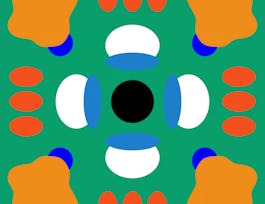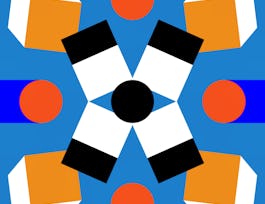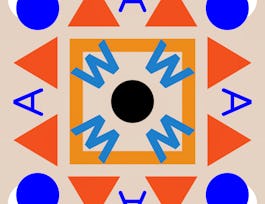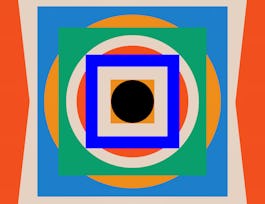Typography is the art of manipulating the visual form of language to enrich and control its meaning. It’s an essential area of skill and knowledge for graphic designers. Typography predates modern graphic design by around 500 years; it is rich in rules, conventions, and esoteric terminology—but it remains an exciting space for invention and expression.


Introduction to Typography
This course is part of Graphic Design Specialization
Taught in English
Some content may not be translated

Instructor: Anther Kiley
167,133 already enrolled
Included with 
Course
(5,584 reviews)
98%
What you'll learn
Review the terminology and measuring system used to describe type
Explore how typefaces tell stories and understand the historic evolution
Conduct a peer-reviewed typesetting exercise
Design of a full-scale typographic poster
Skills you'll gain
Details to know

Add to your LinkedIn profile
2 quizzes
Course
(5,584 reviews)
98%
See how employees at top companies are mastering in-demand skills

Build your subject-matter expertise
- Learn new concepts from industry experts
- Gain a foundational understanding of a subject or tool
- Develop job-relevant skills with hands-on projects
- Earn a shareable career certificate


Earn a career certificate
Add this credential to your LinkedIn profile, resume, or CV
Share it on social media and in your performance review

There are 4 modules in this course
This week, we’ll take an up-close look at typefaces, both as physical artifacts and as works of design. We will study the formal elements that define and give character to type, and understand where they came from and why they look the way they do. We will review the terminology and measuring system used to describe type, and look at the way the form and proportion of letters relate to the practical concerns of selecting and combining typefaces. The week will wrap up with a graded quiz.
What's included
9 videos10 readings2 quizzes1 discussion prompt
This week, we’ll explore the way typefaces express connotative meaning—tell stories—through their association with different time periods, aesthetics, and ideas. Through six short case studies, we will look at the way a typeface’s connotations are shaped by its context, understand the historic evolution of typographic forms, and familiarize ourselves with the way typefaces are classified. You’ll extend your exploration through some independent research into a typeface of your choosing.
What's included
7 videos2 readings1 peer review
This week, we will engage the visual principles and conventions of typesetting. We will look at how the spaces between letters, lines, and blocks of type can be manipulated to refine the appearance and control the meaning of type. We’ll explore the ways typographic hierarchy and grid systems can further organize and clarify type. And we’ll survey the rules and conventions that can add polish to your typesetting. You’ll apply your skills and knowledge in a peer-reviewed typesetting exercise at the end of the week.
What's included
6 videos1 peer review
In our final week, we’ll examine the ways typographic form can dramatically shape the meaning of written language. We’ll survey and analyze possibilities for type treatments—from subtle typesetting choices to dramatic manipulations—by looking at examples of expressive and unconventional typography. At the end of the week, you’ll bring together and apply everything you have learned in this course in the design of a full-scale typographic poster.
What's included
4 videos1 reading1 peer review
Instructor

Offered by
Recommended if you're interested in Music and Art

California Institute of the Arts

California Institute of the Arts

California Institute of the Arts

California Institute of the Arts
Why people choose Coursera for their career




Learner reviews
Showing 3 of 5584
5,584 reviews
- 5 stars
82.76%
- 4 stars
14.55%
- 3 stars
2%
- 2 stars
0.34%
- 1 star
0.34%

Open new doors with Coursera Plus
Unlimited access to 7,000+ world-class courses, hands-on projects, and job-ready certificate programs - all included in your subscription
Advance your career with an online degree
Earn a degree from world-class universities - 100% online
Join over 3,400 global companies that choose Coursera for Business
Upskill your employees to excel in the digital economy
Frequently asked questions
Access to lectures and assignments depends on your type of enrollment. If you take a course in audit mode, you will be able to see most course materials for free. To access graded assignments and to earn a Certificate, you will need to purchase the Certificate experience, during or after your audit. If you don't see the audit option:
The course may not offer an audit option. You can try a Free Trial instead, or apply for Financial Aid.
The course may offer 'Full Course, No Certificate' instead. This option lets you see all course materials, submit required assessments, and get a final grade. This also means that you will not be able to purchase a Certificate experience.
When you enroll in the course, you get access to all of the courses in the Specialization, and you earn a certificate when you complete the work. Your electronic Certificate will be added to your Accomplishments page - from there, you can print your Certificate or add it to your LinkedIn profile. If you only want to read and view the course content, you can audit the course for free.
If you subscribed, you get a 7-day free trial during which you can cancel at no penalty. After that, we don’t give refunds, but you can cancel your subscription at any time. See our full refund policy.

